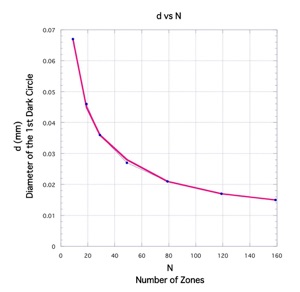Atelier Bonryu(E)
zone plate photography


Atelier Bonryu(E)
zone plate photography





Laboratory: Zone Plate Photography
Theory of Zone Plate Photography
- Number of Zones and Depth of Field -
Resolution vs Number of Zones: In order to design a pattern of a zone plate it is necessary to fix the number of zones appropriately. Theoretically the resolution of an image is improved with increasing the number of zones and it is expected that the image will become clearer. Figure 1 shows the distribution of the light intensity of an image on the focal plane by zone plates with the focal length of 50 mm and zone numbers of 9, 19, and 29. In order to investigate this tendency quantitatively we carried out the same calculation for zone plates with the zone number of 49, 79, 119, and 159, additionally and got an empirical formula for the relation between the number of zones and the resolution. Figure 2 shows a dependence of the diameter of the central circle of the first dark zone on the number of zones (blue points). From this figure it is seen that the resolution is improved by increasing the number of zones. By defining the above diameter as the resolution of the zone plate an empirical formula of a relation between the resolution and the number of zones is obtained as

In Fig.2 this relation is drawn by a red solid line. From the above formula it is known that the diameter of the central circle of the first dark zone becomes small with increasing number of zones in inversely proportional to approximately square root of the number, and we expect a high resolution may be attained by employing a larger number of zones. However, in an actual situation, an image taken by a zone plate with a larger number of zones seems less clear in comparison with an image taken by a zone plate with a small number of zones. This phenomenon may be explained by a reason, “With increasing number of zones the resolution of a photograph is improved and at the same time the depth of field becomes shallower, and, therefore, a photogenic object which is not accurately in focus goes outside of the depth of field and the image of the object becomes unclear”.


Number of Zones and Depth of Field: In order to investigate if the above tentative theory is right we calculated how much shallower the depth of field becomes when there is an error in the position of the image plane. Figure 3 shows the summary of the calculated results for a Fresnel zone plate with the focal length of 50 mm. The horizontal axis is the position of the image plane , b and the vertical axis is the position of the object, a. The inner regions bounded by green, red, and blue curves are those where images are in focus by zone plates with number of zones of 9, 19, and 29, respectively. Here, the boundaries of the regions are determined by positions of objects where the light intensity of image becomes half the maximum intensity for a fixed position (the horizontal axis) of the image plane (it should be noted we employed points of the null light intensity when calculating the resolution). When we choose the position of the image plane at the position of the focal plane (in this case, 50 mm) an image of an object at infinity is of course in focus. Moreover, for example, if the position of the object is at anyplace more than 500 mm from the zone plate with 9 zones the image of it is in focus. In contrast, when the image plane is placed at 58 mm (b=58 mm) from the zone plate only an image of an object placed at 200 ~ 2000 mm can be in focus. It is also understandable that the in-focus range becomes narrower with increasing number of zones. Therefore, in the case of a zone plate with a large number of zones an image plane should be placed more accurately in comparison with a zone plate with small number of zones. For example, when one takes a photograph of an object at 10 m from a zone plate with a focal length of 50 mm an image plane should be placed at 50 mm, and in the case of a zone plate with 9 zones a permissible error in the position of the image is 6 mm. However, for zone plates with 19 and 29 zones the permissible errors of the image plane positions are less than 3 mm and 2 mm, respectively. For this reason it may be difficult to take a clear photograph by a zone plate with a large number of zones when there is an error in the position of the image plane.
Fig.1 Images of a point source on the focal plane of zone plates with f=50 mm, and N=9(green), 19(red), 29(blue).
Fig.2 Dependence of the resolution on the number of zones. Blue points show calculated values and a red solid line is a fitted curve.

Fig.3 Depth of field of zone plates with various zone numbers
The horizontal axis is the position of the image plane and the vertical axis is the position of the object. The inner regions bounded by green, red, and blue solid lines are in-focus regions by zone plates with 9, 19, and 29 zones, respectively.
Effective Wavelength and Depth of Field: Even more important factor concerning the relation between the depth of field and the number of zones is that it is impossible for us to know how much is the dominant wavelength (or the effective wavelength) of the incident lights. As the visible lights contain various lights with different wavelength from about 400 nm to about 700 nm, we decided to employ the intermediate value, 550 nm as the wavelength of the incident light. Therefore, the focal lengths of our zone plate which is designed for the focal length of 50 mm for the wavelength of 550 nm are 68.75 mm and 39.29 mm for the lights with wavelengths of 400 nm and 700 nm, respectively. Because the effective wavelength does not generally coincides with the designed wavelength an error more than several millimeters of the position of the image plane for the effective wavelength case may occur even when the zone plate is made accurately as designed and placed accurately. In such a case it is possible take a clear photograph by using a zone plate with smaller number of zones, by which the image can be in focus for lights with wider range of wavelengths. Actually, we often experience clearness of a zone plate photograph extremely depends on the conditions of the light such as the light intensity, the color, and so on, which may be caused by the above reason.


